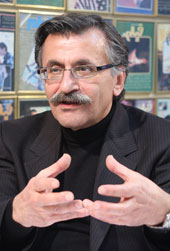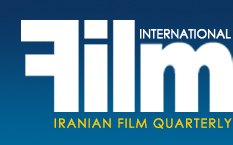|
Interview with Mohammad Mehdi Dadgou on Iranian film economy
Promoting Visual Culture
|
 In the previous issue, we carried two articles on the economic aspects of the Iranian cinema. Now, we have conducted an interview with Mohammad Mehdi Dadgou, an active figure of the Iranian cinema in the early post-revolution years. He has produced major works some of which are still considered the best examples of cultural movies. Dadgou was among managers, planners and designer of macroeconomic policies of cinema at a time that early steps were taken to purify cinema from obscenities. His tone in the following interview is not like a formal manager and while expressing his viewpoints about major cinema issues, he recounts interesting memories. In the previous issue, we carried two articles on the economic aspects of the Iranian cinema. Now, we have conducted an interview with Mohammad Mehdi Dadgou, an active figure of the Iranian cinema in the early post-revolution years. He has produced major works some of which are still considered the best examples of cultural movies. Dadgou was among managers, planners and designer of macroeconomic policies of cinema at a time that early steps were taken to purify cinema from obscenities. His tone in the following interview is not like a formal manager and while expressing his viewpoints about major cinema issues, he recounts interesting memories.
Film International: Given your background in cinema, either as manager or producer, and that you are well-informed about economic issues and salaries in cinema during past years, our first question is about salaries paid to film crew and directors compared to total cost of a movie. Are those salaries balanced and reasonable?
Mohammad Mehdi Dadgou: Although the readership of Film International knows about more specialized issues, I think I better start at the beginning. Economy of cinema is a totality of which salaries constitute a single part which cannot be understood without good knowledge of that totality. When looking at the Iranian cinema from an economic viewpoint, we are looking at a long shot of the Iranian cinema in which policies and general trend of cinema should be given precedence over purely economic relations.
FI: Are you alluding to viewpoints of cinema managers?
MMD: I am talking in general terms which includes managers, directors, public sector and private sector alike. When cinema grows to the extent that its private part expands, it would be logical for the private sector to look for a share in policymaking. Iranian cinema’s macro policies were redefined in 1982 and that process focused on production. They meant that cinema should be looked upon as an industry. When talking about industry, more attention should be paid to quantity. Quantity means the number of films we produce in a year regardless of their quality. This is cornerstone of film economy. Many countries which produce prominent films are not considered to have a film industry. On the opposite, India owns a powerful and prosperous cinema, even if we don’t like its productions.
FI: You mean an economic structure should be analyzed with no regard to quality of its products?
MMD: We must first build a plant and practice production before production cycle is complete and resources are gathered. Here, resources mean capital, equipment, manpower and the like, which together, give rise to an industrial entity. Afterwards, we can talk about identity as well as implications, prosperity and future plans. “Organizational lifetime” is a major topic in management. The lifetime of every organization, system, or plant can be divided in different parts: birth, childhood, young adulthood, adulthood, old age and death. Correct management can prolong the period of youth as well as useful lifetime of every plant. Therefore, when you talk about an industry as a national topic, the managerial structure should act in such a way as to keep that industry young and prevent its death. Organizational lifetime of a bankrupt company is practically over. Through careful study of this issue, you would know whether management has had any plans to prolong the lifetime or not.
FI: Does this viewpoint also apply to cultural management?
MMD: Exactly, but with some difference. For example, management in cinema is somehow different from management of an iron smelting complex. There are factors on cultural management which are more important than capital. You may think that a wealthy country is in possession of all means to run a prosperous film industry, but this is not true. Therefore, we must take note of many cultural, historical, social, and political issues. Firstly, we must see how we had fared in the 30 years which have followed the Islamic Revolution of 1979 and how the modern Iranian cinema has fluctuated in that period. Those fluctuations can be considered under general title of industrial economy. Iranian cinema was born in the absence of many other media and media relations and it has gained a large audience; an audience which has fairly related to that cinema. Statistics related to 1993 and onward show that the population of the audience has greatly decreased and the existing rifts in film economy in Tehran and other cities were not extant at that time. Of course, it is true that other means for passing leisure time have been introduced to our social relations. Perhaps, cinema was one of our cultural problems in early post-revolution years and, therefore, we had to come up with a new definition of cinema.
SUBSCRIBE
[Page: 58]
|
|
|
|
|
President & Publisher
Massoud Mehrabi
Editors:
Sohrab Soori
Translators:
Sohrab Soori
Behrouz Tourani
Zohreh Khatibi
Saeed Khamoush
Contributors
Shahzad Rahmati
Saeed Ghotbizadeh
Advertisements
Mohammad Mohammadian
Art Director
Babak Kassiri
Ad Designers
Amir Kheirandish
Hossein Kheirandish
Cover Design
Alireza Amakchi
Correspondents
E.Emrani & M. Behraznia (Germany)
Mohammad Haghighat (France)
A. Movahed & M. Amini (Italy)
Robert Richter (Switzerland)
F. Shafaghi (Canada)
B. Pakzad (UAE)
H. Rasti (Japan)
Print Supervisors
Shad-Rang
Noghreh-Abi
Gol-Naghsh
Subscription & Advertising Sales
Address: 10, Sam St., Hafez Ave., TEHRAN, IRAN
Phone: +98 21 66722444
Fax: +98 21 66718871
info@film-magazine.com
Copyright: Film International
© All rights reserved,
2023, Film International
Quarterly Magazine (ISSN 1021-6510)
Editorial Office: 5th Floor, No. 12
Sam St., Hafez Ave., Tehran 11389, Iran
*
All articles represent views of their
authors and not necessarily
those of the editors
|
|
|

